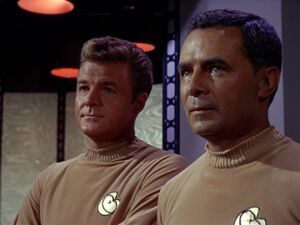Starfleet Auxiliary
| Starfleet Auxiliary | |
| Founded |
2161 |
| Affiliation |
|
| Headquarters |
Tellar Prime |
| Primary Mission |
Logistical Support |
| Leadership |
Admiral Lashnov Zagh (Tellarite Male) |
| Status |
Active |
| Template:Organisation | |
Starfleet Auxiliary is a component of Starfleet that operates passenger liners, tankers, freighters, transports, and some research vessels in support of the starships and capital starships in mainline Starfleet service, equivalent to a Merchant Marine. The personnel in this service are subject to Starfleet's regulations (including the Prime Directive) but have more limited training and significantly different career paths than their counterparts in the main fleet.
History
When Starfleet and the United Federation of Planets were founded in 2161, a subordinate service to handle logistical support for Starfleet's exploratory, defensive, diplomatic, and humanitarian mandate was envisioned. While each of the founding members had their own merchant marine services, the Starfleet Auxiliary was created to create a common set of regulations and training standards, and a unified dispatching system to turn these disparate systems into a working whole, just as the early Starfleet needed to combine aspects of the founders' scientific and defensive arms.
With ships from the Human, Vulcan, Andorian, and Tellarite merchant fleets to start with, and ships from less powerful worlds joining as negotiations continued, Starfleet Auxiliary's growth was rapid in the first few decades of its existence as starbases and interstellar shipping lanes were developed. The Federation Council decided to base the Starfleet Auxiliary on Tellar Prime rather than on Earth, because of the Tellarites' great experience in mining, construction, and other logistics projects. Even in the 2390s, the upper echelons of the organization continue to be dominated by Tellarites in the same way that Starfleet is by Humans.
By the 2230s, there were several hundred purpose-built ships in the auxiliary, including passenger ships, tankers, and freighters. By the 2260s, the fleet included surveyors following up on non-biological and non-cultural surveys (generally looking for minerals and other resources) and hospital ships as well. As time went on, the Starfleet Auxiliary has entered a steady pattern of assimilating retired Starfleet vessels into its inventory, as well as operating ships purpose-built for civilian and auxiliary service. In the mid-24th century, there were just as many Oberth and Miranda-class ships in auxiliary service as in main line service, the older units of this class living on in less rigorous duties.
The logistical complexity of operating hundreds of starbases and thousands of lesser stations and starships necessitated similar growth in the Starfleet Auxiliary, and by the 2390s ships belonging to the auxiliary can be found in all corners of the Federation.
Organization
Somewhat ironically, the Commander, Starfleet Auxiliary is not actually a member of the Starfleet Auxiliary, but is a commissioned Starfleet officer reporting to the Chief of Starfleet Operations and holding the rank of admiral. Indeed, there are no members of the Starfleet Auxiliary with ranks higher than captain; officers wishing to advance beyond this stage must go through additional training such as Command School and then be commissioned in Starfleet, instead.
Each type of vessel has its own commander under this level. For example, the Commander, Passenger Liners and the Commander, Surveyors are each Rear or Vice Admirals overseeing all of the vessels of those two designations. These type commanders assign vessels either to specific sectors, where they fall under the jurisdiction of that sector's commander, or to various Starfleet offices and bureaus, where they fall under the jurisdiction of that office's director.
For example, a Sydney-class passenger liner might be assigned to regular service between Starbase 4 and a smaller station in the same sector, thus falling under the jurisdiction of Starbase 4's commanding officer, the flag officer in command of Sector 4. As another example, an Aerie-class surveyor might be specially equipped to transport botanical samples, and so would be assigned to the Bureau of Xenobotany under Starfleet Science, and would be under the jurisdiction of the Director of the Bureau of Xenobotany.
The effect of this allows the Starfleet Auxiliary to operate without a parallel chain of command to Starfleet itself.
Personnel
One of the original branches of Starfleet, the Starfleet Auxiliary has been in operation since the founding of the Federation in 2161. The personnel in this branch are highly trained in starship navigation and operations, engineering, and/or other related duties, but don't have the exploratory and tactical training that is given to members of Starfleet itself. These personnel are commissioned through a number of different means, including several academies, training centers, and direct commissioning programs that take into account life experience and aptitude tests.
Officers and other personnel of the Starfleet Auxiliary wear variants of the standard Starfleet uniforms with different insignia; generally speaking the day-to-day uniform of a member of this service varies greatly based on their assignments. The crews of freighters and tankers will spend a lot of time in coveralls, while the crews of passenger liners will often wear white uniforms to set themselves apart from their passengers, who are often Starfleet officers themselves.
The rank structure in the Starfleet Auxiliary is simplified from Starfleet itself, based on merchant traditions that informed such services as the Earth Cargo Service, which itself is derived from Merchant Marine Traditions on Earth, combined with structures used by the Imperial Andorian Logistics Corps, the Tellarite Merchant Navy, and the Vulcan National Merchant Fleet. The line between officers and enlisted is much blurrier in an auxiliary context, and it is possible for someone to work their way up directly from Crewman to Captain over an extended period of time through on-the-job training in a way that's much easier than it would be in Starfleet itself. On the flip-side, the licensing and time in-grade requirements for each level are inflexible.
| Insignia | Deck Department | Engineering Department | Steward's Department | Surveyor's Department | Time in Previous Grade |
|---|---|---|---|---|---|
| ⚫⚫⚫⚫ | Captain | 10 Years | |||
| ⚫⚫⚫ | Master | Chief Engineer | Chief Steward | Chief Surveyor | 5 Years |
| ⚫⚫ | Lieutenant | Lieutenant | Lieutenant | Lieutenant | 4 Years |
| ⚫ | Ensign | Ensign | Ensign | Ensign | 1 Year |
| ○○ | Acting Ensign | Acting Ensign | Acting Ensign | Acting Ensign | 4 Years |
| ○ | Petty Officer | Petty Officer | Petty Officer | Petty Officer | 1 Year |
| N/A | Crewman | Crewman | Crewman | Crewman | N/A |
Direct enlistment as a crewman includes six weeks of training, before spending the remainder of the first year learning on the job on a ship, becoming a petty officer upon the satisfactory completion of several training programs at the end of that probationary period. After five total years of enlistment, members can apply to become acting ensigns, taking additional training and apprenticing under more challenging jobs. Alternatively, if an individual goes through a service academy (usually a three-year program), they would start in service as an acting ensign. After one year continuing to learn on the job, the member is then promoted to ensign or discharged.
After four years as an ensign, a member is eligible for promotion to lieutenant, which is the requisite rank for most department head roles on smaller ships. After five more years, they are eligible to become the senior rank in their particular department, where the titles very. Finally, members of the deck department who have been masters for at least 10 years are eligible promotion to the rank of Captain, and are therefore eligible to command the largest ships in auxiliary service.
Vessels
Starfleet Auxiliary operates a wide variety of vessels, including some classes that either currently or formerly see service in Starfleet itself. A good example of this is the Olympic-class utility cruiser, which is operated exclusively by Starfleet in its science configuration, exclusively by the Starfleet Auxiliary in its passenger liner configuration, and by both services in the hospital ship configuration.
- Aerie-class surveyor & transport
- Olympic-class liner and hospital ship
- Sydney-class liner
- Antares-class freighter
- Miranda-class surveyor & transport
- Constellation-class transport



